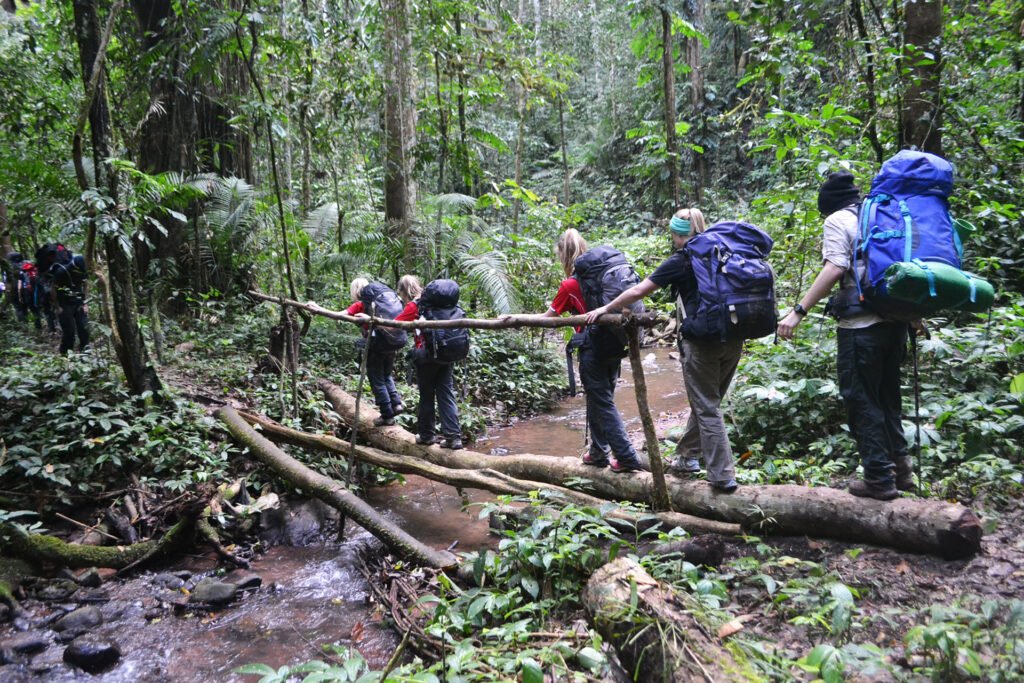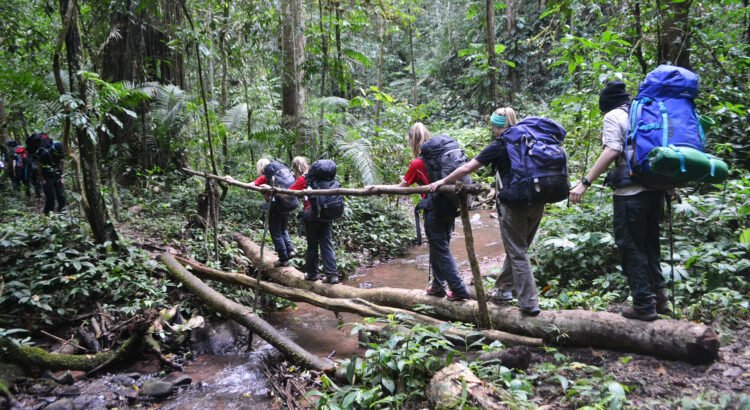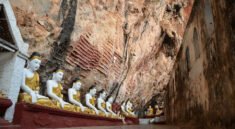
Hidden deep in the misty folds of northern Laos, bordered by China to the north and Myanmar to the west, lies a region where lush jungles, winding rivers, and ancient tribal customs converge. This is Luang Namtha—a quiet town that might seem unassuming at first glance, but one that opens up into a wilderness that few travelers have seen, let alone understood. It is a true frontier, not of borders, but of biodiversity, community, and cultural immersion.
Here, trekking is more than a physical journey; it’s a window into another rhythm of life. One where motorbikes give way to jungle paths, time is measured by daylight and firewood, and the sounds of birdsong and distant gongs echo through valleys untouched by modernity. Luang Namtha offers some of Southeast Asia’s most authentic trekking experiences, bringing you face-to-face with remote tribal villages, unspoiled jungle landscapes, rare wildlife, and the enduring spirit of Laos.
A Gateway To Diversity: Natural And Human
Luang Namtha sits at the intersection of Nam Ha National Protected Area and a mosaic of hill tribes, each with their own language, dress, and traditions. The town itself is small—more of a launching point than a destination—but it is ringed by ecological richness and cultural depth.
This region is home to over 20 ethnic minority groups, including the Akha, Khmu, Tai Dam, Lanten, and Hmong peoples. Their villages are nestled in hillsides or forest clearings, often accessible only by foot. Many still live self-sufficient lives based on shifting agriculture, foraging, and artisanal crafts.
Meanwhile, the surrounding jungles are part of one of Southeast Asia’s last great wildernesses. The Nam Ha Protected Area, a 2,224-square-kilometer expanse of primary forest, is teeming with rare flora and fauna—clouded leopards, Asiatic black bears, hornbills, langurs, and countless endemic plant species. For nature lovers, it’s a treasure trove. For trekkers, it’s a challenge and an invitation.
The Trekking Experience: Footsteps Into Another World
Trekking in Luang Namtha is not a one-size-fits-all activity. You can choose from half-day hikes to multi-day expeditions, but the true heart of the experience lies in the 2–4-day village treks that take you deep into the rainforest and ethnic homelands.
Day 1: Into The Forest
The journey often begins with a ride on the back of a tuk-tuk or songthaew to a trailhead far from paved roads. Once the engine fades, you step into a world where the forest breathes and sings.
The trail winds through bamboo groves, jungle canopy, and thick ferns, past rivers where water buffalo bathe and colorful butterflies flit through shafts of light. Local guides—usually from one of the nearby villages—explain medicinal plants, animal tracks, and traditional uses of jungle resources. You’ll learn to identify vines used for basket-weaving, barks that treat fevers, and edible shoots that sustain communities in the rainy season.
Lunch might be cooked on a bamboo fire, wrapped in banana leaves—sticky rice, forest mushrooms, maybe a bit of fish grilled over the coals. It’s not just food; it’s a lesson in resourcefulness and respect for the environment.
Day 2: Village Life And Cultural Exchange
By nightfall, you reach a hill tribe village, such as those of the Akha or Khmu. These communities live much as they have for generations, though solar panels and smartphones have begun to appear in small numbers.
Your accommodations are usually a family homestay or a communal guest hut, simple but warm. The hosts might prepare a meal of wild greens, local herbs, free-range chicken, and of course, rice. Sitting cross-legged around the fire, you share stories through smiles, gestures, and sometimes the help of a bilingual guide.
Villagers may demonstrate textile weaving, cotton spinning, or basketry. Children peek curiously through bamboo walls. If you’re lucky, an elder might play a traditional jaw harp or recite stories passed down orally for generations.
This is not a show for tourists—it’s life, unfolding in rhythm with the mountain breeze and the scent of cooking fires.
Day 3: Higher Into The Hills Or Downriver By Raft
Longer treks might take you higher into the hills, through more remote hamlets where few visitors ever tread. Here, the path may narrow, with steep climbs and river crossings, but the reward is absolute immersion: panoramic views of unbroken forest, a silence so deep you can hear distant waterfalls, and a sense of walking through a land that time forgot.
Alternatively, some treks descend toward the Nam Tha River, where bamboo rafts or longboats carry you down meandering waters, back toward Luang Namtha. Along the way, you’ll see fishermen casting nets, children playing in the shallows, and waterbirds dancing through the reeds.
Sustainable Tourism: A Model Worth Celebrating
One of the most remarkable aspects of trekking in Luang Namtha is how it has been developed with community-based, eco-friendly principles. Unlike mass-tourism hubs, here the local government and NGOs have worked with ethnic communities to create treks that benefit villages directly.
- Local guides are trained from tribal communities, offering income and pride in their heritage.
- Village homestays rotate hosting duties to ensure fair economic distribution.
- A portion of the trek fee goes into a community fund for schools, sanitation, or infrastructure.
- Treks follow low-impact principles, with waste carried out, fires controlled, and trails maintained naturally.
This model of tourism is rare and deeply respectful. It allows travelers to engage without exploitation, to learn without appropriating, and to walk in places that remain pristine because they are loved, not consumed.
The Biodiversity: More Than Green
The region’s ecological diversity is staggering. As you trek, you may encounter:
- Birds: Rufous-necked hornbills, crested serpent eagles, and broadbills.
- Mammals: If extremely lucky, the calls or tracks of langurs, civets, or bears.
- Insects and reptiles: From giant centipedes to jewel-toned beetles and skinks.
- Plants: Giant fig trees, orchids clinging to mossy trunks, and carnivorous pitcher plants.
But more than just a list of species, the forest here feels alive and interconnected, pulsing with unseen life and energy. You’re not just observing it—you’re walking within a living organism, part of a delicate, thriving whole.
When To Go: Seasons Of Green And Gold
Luang Namtha can be visited year-round, but seasons impact the trekking experience:
- Dry Season (November–February): Cool mornings, clear skies, best trail conditions.
- Hot Season (March–May): Dry but hotter; river levels lower for boating.
- Rainy Season (June–October): Lush and green, but muddy trails and leeches common. Still beautiful if you’re prepared.
No matter the time of year, early starts are best to enjoy morning mist, wildlife activity, and cooler air.
What To Bring
For a meaningful and safe trek, essentials include:
- Proper footwear: Waterproof trekking shoes with grip.
- Quick-dry clothes: For humid days and river crossings.
- Rain gear: Especially in the wet season.
- Bug repellent and sunscreen
- Water purification (guide may provide boiled or filtered water).
- Headlamp, toilet paper, small towel
- Gifts for villages? Ask your guide—often simple school supplies or snacks are appreciated, but donations should be coordinated to avoid disrupting local dynamics.
More Than A Trek: A Transformation
Walking through Luang Namtha’s forests and tribal lands is not just a scenic activity. It is a profound exercise in humility, awareness, and connection. You slow down. You listen more. You learn that the forest is not just beautiful, but bountiful, and that people can live in harmony with it, without conquering it.
As you return to the modern world—maybe to Luang Prabang, Vientiane, or beyond—you’ll carry more than photos. You’ll carry the smoke-scented memory of village hearths, the echo of gongs in distant valleys, and the soft, muddy path that once cradled your every step.
Because Luang Namtha doesn’t just show you Laos—it shows you what the world once was, and perhaps what it can be again.




